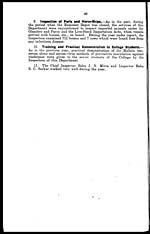Medicine - Veterinary > Civil Veterinary Departments > 1895-1951 - Annual report of the Civil Veterinary Department, Bengal > 1923-1933 - Civil Veterinary Department Bengal reports 1923-33 > Annual reports of the Civil Veterinary Department, Bengal and Bengal Veterinary College for the year 1931-32
(493) [Page 47]
Download files
Individual page:
Thumbnail gallery: Grid view | List view
![(49) [Page 47] -](https://deriv.nls.uk/dcn17/7700/77009211.17.jpg)
Raymond Research Laboratory.
Babu K. K. Banerjee, Laboratory Assistant, held charge of the
Laboratory and the Serum Cellar of the Province under the Principal's
control during the year under review.
2. He was deputed to Rangpur in the middle of June 1931 to assist
the then Officiating Director, Civil Veterinary Department, Bengal, in
investigating the cause of high mortality amongst the calves of the
Rangpur Cattle Farm. Mr. MacGregor, later on, visited the Farm as
Veterinary Adviser and duly submitted to Government a detailed
report.
3. Training.—Instructions regarding the properties, dosage and
application of common biological products, and training in general
laboratory methods were, as usual, imparted to the senior students of
the College. Lectures illustrated with lantern slides (of pathological
interest) were delivered to the Class C students.
4. Two senior assistants from the Bengal Vaccine Depot attended
the Laboratory and were given a short training of three months, in the
detection and suppression of bovine infectious and contagious diseases,
as well as care and management of cattle in health and disease.
5. Post-Graduate Course.—Government decided to hold it in
abeyance in view of the meagre support the scheme received from the
district boards consulted in the matter.
6. Serum Simultaneous Method of Inoculation against Rinderpest.—
Due to widespread epidemic of rinderpest in Calcutta and suburbs, all
the Government cattle of the College were protected during the year by
the above method against the disease, as they were constantly exposed
to such infection being brought in by outside animals. The inocula-
tions were conducted in a "Stand Still Camp" especially organised for
the purpose. A small herd of freshly imported Jersey cows belonging
to a private gentleman of Calcutta were also immunised successfully.
This was of great advantage to the College students by way of practical
demonstration and in gaining first-hand knowledge in conducting such
inoculation campaigns in the actual field.
7. Rabies.—During the year under review, 76 brains of dogs and
other animals, suspected and clinically confirmed cases of rabies, were
received from the College Hospital, District Veterinary Assistant
Surgeons, Police and private individuals, and examined. Diagnosis was
confirmed in 56 cases and the parties concerned were immediately
informed together with recommendation for anti-rabic treatment in cases
of bites or licks received from such animals (vide Appendix A).
8. Examinations of specimens.—Altogether 354 specimens of blood,
fœces, urine, skin-scrappings and other morbid materials were received
from the College Hospital, District Veterinary Assistant Surgeons,
Set display mode to: Large image | Zoom image | Transcription
Images and transcriptions on this page, including medium image downloads, may be used under the Creative Commons Attribution 4.0 International Licence unless otherwise stated. ![]()
| Permanent URL | https://digital.nls.uk/77009209 |
|---|




